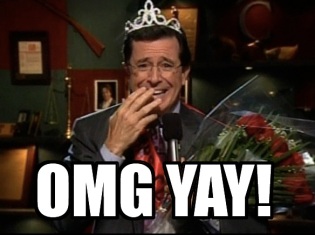The last few weeks, because I have not been able to maintain the terrific sales numbers I achieved over the Christmas holidays for my historical mystery, Maids of Misfortune, I have noticed a growing sense of disappointment. In addition, two of my friends who have recently self-published books, encouraged to do so by my solid sales, have sold very few of their books. Naturally I feel partly responsible for their frustration. Finally, the author Facebook site I started last month only has 74 “likes,” most of them other authors who “liked” my site in exchange for me “liking” their sites, instead of the fans of the book I hoped to attract. I confess these three things were beginning to undermine my generally enthusiastic state of mind towards self-publishing. A few days ago, however, I experienced an interesting “attitude adjustment.”
First of all, I read a guest post on J.A. Konrath’s blog, A Newbie’s Guide to Publishing, by an author Guido Henkel where Henkel described how, despite all the changes he had made to his book Demon’s Night, (new cover, new description, better editing, etc), after a relaunch of the book four weeks ago he hadn’t seen any great improvement in sales.
I found myself mentally chiding Henkel for being so impatient. Four weeks, particularly if he hadn’t been doing anything to let the potential readers out there know about his new and improved book, is a very short period of time in the self-publishing world. And one of the wonderful benefits of self-publishing is that there is time to build a market for our work. Unlike traditionally published authors, we aren’t facing the 6-8 week window, where one needs to achieve enough “sell-through” before your book is remaindered and your book is labeled a failure. (Of course today, when I checked Henkel’s ranking on Kindle, Demon’s Night was now in the top 100’s of several categories. This should help improve his sales dramatically, which I am sure was his hope, and Konrath’s plan; so he is probably no longer feeling so discouraged.)
However, thinking about Henkel reminded me that it took me seven months to reach the point where my book was selling enough copies so that it was high enough in the rankings to reach its potential market. Seven months and a whole series of actions on my part to increase my sales. This also reminded me if I had expected to make a lot of sales instantly that I might very well have gotten discouraged and not taken the actions that did ultimately achieve success.
Fortunately, when I first published in December 2009, I really hadn’t heard of very many previously unpublished indie authors hitting it big, so my expectations were very modest. I was honestly delighted after four months of sales to discover I had sold 158 books, because this meant someone besides my circle of family and friends had actually bought my book.
A second occurrence again brought home how changing expectations can be a trap for an indie author. I was rewriting a talk I had given in November about the new opportunities in ebook and independent publishing and I ran across the statement that as of October 2010 I had sold over 2100 books, and that since I was then averaging 14 books sold a day, I estimated that in the next twelve months I would sell over 5000 books. I remember being so proud of this, and it eliciting a distinct gasp from my audience of academics. (Academic monographs seldom sell more than 600 books in a title’s lifetime.)
That was my expectation five months ago, but when I sold nearly 3000 books in one month (January) my expectations changed. Now, even though I have sold over 8000 books in just six months-way over my estimate, I was discouraged because my average sales for March was down to 42 books per day, a number that would have made me ecstatic five months ago. Objective reality hadn’t changed, my expectations had.
Hence my need for an attitude adjustment.
As an indie author I needed to remember what the process would be like if I was going through the traditional (commercial) publishing process. How long it takes to get an agent. How long it takes an agent to find, if they ever do, a publisher. How small most advances are. How long it takes to get the book actually in print. How short the time period a book stays on the shelf, and how seldom the book pays back its advance so that it will start to pay out royalties. Finally, how short a time most books stay in print.
As an indie author I needed to remember that in self-publishing the time line is reversed. It takes very little time (from a few days to a few months) to get your book published (cover designed, interior formatted, product description written, files uploaded) but you have forever to sell it-particularly if you have written fiction, or in my case an historical mystery that is never going to seem “dated.”
As an indie author I needed to remember that indie publishing and ebook publishing are transitioning so rapidly that expectations built on today’s experience are probably going to be outdated tomorrow. Experimentation not expectation needs to be my watchword. For example, I know one of the reasons my author site hasn’t yet attracted many fans is that at the start I didn’t set up any mechanism to connect up with people who bought my book.
I did have my website listed at the end of the book, but this website has remained static, and I didn’t even have a contact email on it until recently. Truth was, I really didn’t expect to have fans! Now I have an email address, I am careful to respond when someone reviews my book on GoodReads and other sites, and I plan to update my ebook with a link to my facebook author site at the end, to encourage readers who liked the book to go on and sign up. Maybe I will even institute my first contest and giveaway to get more people signed up! A drop in sales doesn’t mean the market has dried up, it means I need to be more experimental in expanding my reach to the market that exists.
These tactics may work or they may not. My sales may go up again when we hit the summer holidays, or they may not, my sales of my second book may match or exceed that of my first, or they may not. But the point is, I needed to regain the perspective I started out with, that the benefit of self-publishing was that a book I had worked hard on and believed was good got to see the light of day and wasn’t stopped by some gatekeeper. I needed to remember its success or failure to sell was contingent on the work itself and my efforts to market it (not some corporate marketing department or book store purchaser).
With that perspective I can once again rejoice whether 40 people (my sales number last night) or only one person buys one of my books or stories. Because without self-publishing, no one would have been reading Maids of Misfortune, or Dandy Detects, and that would have been the real disappointment.
This is a reprint from M. Louisa Locke‘s The Front Parlor.







